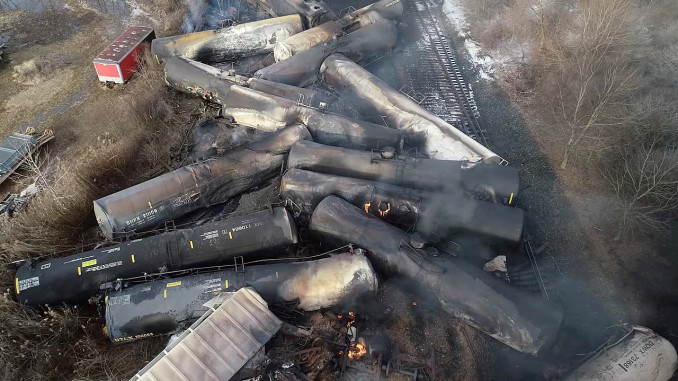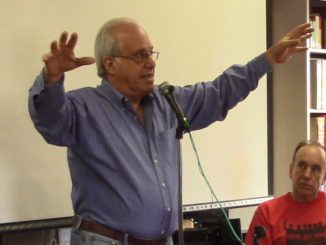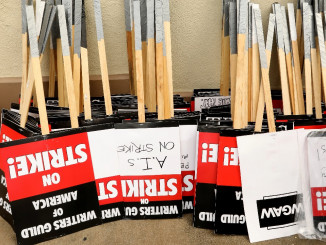
Millions around the world were horrified by the pictures of the fiery explosion of Norfolk Southern freight train 32N which derailed while carrying deadly chemicals through a small Ohio town. Eventually the entire town, East Palestine, was forced to evacuate as the fires generating clouds of toxic smoke continued for five days. The smoke contained phosgene, a deadly gas used in World War I trench warfare. Network TV stations focused on the danger to the townspeople and the evacuation. They wrapped up their coverage with the good news that no one had been killed even though no one knows what the long-term consequences of the pollution will be. When their coverage ended, they had said little about what caused the near catastrophe, which they called an accident.
It was no accident. Had the networks given airtime to the many angry and well-informed railroad workers, the public would have learned that, far from being an accident, what happened in East Palestine was the inevitable consequence of the drive for ever-greater profits directed by the reckless owners of big railroads.
In the last decade all the big railroads in the United States and Canada have made record profit margins, in 2019 as high as 50%; last year only 41%. They succeeded in cutting down the workforce by a third while revenues have skyrocketed. A key technique of this drive is called “Precision Scheduled Railroading” (PSR), which operates in tandem with measures including layoffs to decrease the number of workers. PSR forces the reduced number of railroad workers to work unsustainably long hours. One consequence of short staffing is that management routinely cancels time-consuming work practices that contribute to safer train movement.
Thanks to the short staffing and rigid PSR schedules, train cars are not allowed to stay in the yards long enough for the remaining workers to do proper inspections and make repairs on the spot. Without enough time for inspections, cars with wheels, axles and couplers about to fail sometimes leave the yards unrepaired. The immediate cause of the derailment of Train 32N appears to have been such a failure in the middle of its scheduled run between Indiana and Pennsylvania.
When positioning the cars for 32N, Northern Southern management put the heavy tanker cars carrying the toxic, explosive chemicals near the back of the train. This meant that they would likely smash into the cars ahead and derail most of the train in the event of an emergency stop. It is a long-established safety procedure to load the heaviest cars directly behind the even heavier locomotives pulling the train. However, proper positioning of heavy freight cars while making up a train can take more time and expense which is contrary to the profit-maximizing goals of PSR.
Workers and railroad safety experts have complained for years about the reckless way the railroad owners run their companies. It turns out that the government has been and still is a long-term accomplice of the bosses and their recklessness. For example, the U.S. Department of Transportation (DOT) has watered down safety regulations to the point that Train 32N, fully 9300 feet long, pulling 151 cars, including 20 cars full of explosive toxic chemicals, was not considered a “high hazard flammable train” by the U.S. Government.
One of the safety measures the DOT has stalled, through both Democratic and Republican administrations, would require railroads to upgrade the 100-year-old design of brakes. Presently the braking system used on freight trains is not instantaneous; it proceeds from the front of the train to the rear, and on a miles-long freight train this can take minutes. It is also the basic reason that the heaviest cars should be right behind the locomotive. Safety advocates have proposed for nearly a decade that railroads be required to install “Electronic Controlled Pneumatic” (ECP) brakes. This modern braking system – which has been fully tested – would operate simultaneously through the entire length of a train, causing it to stop in a shorter distance while eliminating the danger that cars at the rear would bang into the cars ahead of them, the ones that slow down first.
One justification the Department of Transportation offers for not ordering railroads to upgrade to the improved braking system is their concern about “the capital investment required.” They make it sound like the highly profitable railroads cannot afford the cost. It seems that instead of shelling out for the new braking system, the railroad bosses prefer to spend their gigantic profits on stock buybacks which only benefit the top management and the corporate owners. The DOT regulations support this dangerous behavior.
Will the railroads continue to elevate profits over all other considerations? Railroad workers have begun to speak out and stand up to their arrogant bosses. Most of them were ready to strike against their impossible working conditions, which directly and indirectly undercut safety for both the public and the workers. Only Biden’s and the Congress’s eagerness to force a contract favoring the bosses down the workers’ throats stopped that movement, at least for a time. If railroad workers learn from their immediate experience with the government (not to mention railroad workers’ militant history), then maybe next time will be different. The issues that provoke resistance are certainly not going away.




